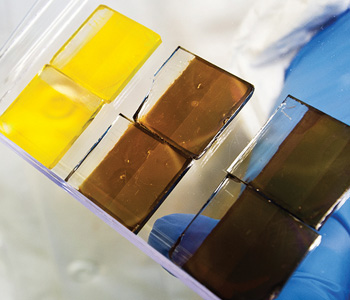 Perovskite cells created in the U.S. National Renewable Energy Lab (NREL) using a precursor solution that converts from a liquid base to an absorber in a device. Photo by Dennis Schroeder/NREL
Perovskite cells created in the U.S. National Renewable Energy Lab (NREL) using a precursor solution that converts from a liquid base to an absorber in a device. Photo by Dennis Schroeder/NREL
In the last few years, the photovoltaic (PV) industry has stood up and taken notice of a not-so-new yet very exciting light-soaking material. A well-known mineral, called perovskite, has suddenly become very popular with PV researchers, and its popularity shows little sign of abating.
Perovskite was discovered by Berlin native Gustav Rose in Russia’s Ural Mountains in the late 19th century, and he named it in honor of Russian mineralogist Count Lev Aleksevich Perovski. The “wild” type of the mineral is calcium titanate (CaTiO3), but perovskite’s structure welcomes a range of elements, making it quite versatile. Until recently, most forms of perovskite were studied primarily for their ferroelectric, piezoelectric and semiconductor properties. But in 2009, the material’s remarkable PV properties were discovered. Since then, perovskites have become a bright star in the PV firmament.
“[Perovskite] was providing remarkable conversion efficiencies in a very short time after first discovery,” said Juan Bisquert of Universitat Jaume I in Castelló, Spain. “Then, in the first months of 2013, we noticed that efficiencies were rising rapidly towards 15 percent. This was a totally new phenomenon in [the] history of photovoltaics. Everybody wanted to join.”
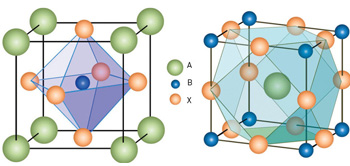 The crystal structure of perovskites, ABX3, is the key to understanding its potential as a high-efficiency solar collector. A large cation (A) resides at the center of the crystal structure, and, together with metal cations (B), is bonded to the surrounding halides (X).
The crystal structure of perovskites, ABX3, is the key to understanding its potential as a high-efficiency solar collector. A large cation (A) resides at the center of the crystal structure, and, together with metal cations (B), is bonded to the surrounding halides (X).
The ABX advantage
What makes perovskite so interesting to solar researchers is its ternary structure, ABX3, where A is a large metal cation, B is a smaller metal cation and X is an anion that binds them together. Perovskites can be made in the form A(Bx'By")X3, where B' and B" are different elements with different oxidation states, and x + y = 1. The X can represent either oxygen, forming an oxide perovskite, or chlorine, bromine or iodine, forming a halide perovskite. Oxide perovskites have been studied for decades as useful semiconductors (albeit with occasionally interesting photonic effects), but it is a halide perovskite—methylammonium lead halide (MAPbX3, where X3is Br3, I3or I3–xClx, and MA denotes CH3NH3)—that has attracted the attention of the PV community.
ABX3 perovskites have some specific technical and practical advantages as PV materials:
Favorable absorption and band gap. ABX3 perovskites offer strong light absorption and a band gap energy of about 1.5 eV. While oxide perovskites offer a wider band gap than halides, allowing more wavelengths of light to enter, they have a lower absorption coefficient, and thus cannot absorb as much of the energy as halide perovskites (those formed with chlorine, bromine or iodine) at a given wavelength. This tradeoff between band gap and absorption coefficient is one of the major challenges researchers have to deal with when designing the “perfect” ABX3 perovskites for PVs.
So what is the optimal band gap for an ABX3 perovskite to be used in a solar cell? According to research by Yang Yang and his lab at the NanoSystems Institute of the University of California, Los Angeles (UCLA), USA, the theoretical ideal band gap for PV materials is 1.34 eV. This would allow the highest absorption coefficient over the widest possible segment of the solar spectrum. (For reference, crystalline silicon has a band gap of 1.1 eV, allowing it to react to light with wavelengths up to 1,100 nm.)
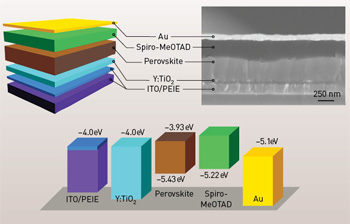
(Top) Layers of a perovskite-based solar cell. (Bottom) The energy levels (relative to vacuum) of each functional layer in the solar cell. ITO/PEIE = indium tin oxide modified with polyethyleneimine ethoxylated; Y:TiO2 = yttrium-doped titanium dioxide; Au = gold. Adapted from Y. Yang, University of California, Los Angeles
Good charge mover. Charge separation and transportation within a PV material are, of course, highly important characteristics, and perovskites deliver well. The material has weak exciton (electron-hole) binding energy, meaning that excitons can be separated quickly and efficiently, forming freely moving electric charges. Electron and hole diffusion lengths in perovskites range from 100 nm to as high as 1 µm. Because the thickness of the perovskite layer in a typical thin film is a flexible 300 nm or less, the diffusion length is large enough to readily transport charges to collectors.
Low manufacturing cost. Another potentially key advantage for perovskite PVs is manufacturing cost. As minerals go, perovskites are generally easy to work with, and can be formed into powders, thin films and single crystals. The bulk materials and manufacturing processes for perovskite-based PVs are quite inexpensive, and the power conversion efficiency is steadily climbing.
Dye-sensitized solar PVs (which replace liquid sensitizers in traditional structures) and related PV technologies can be manufactured with readily available raw materials and at relatively low temperatures. Inorganic semiconductors used for sensors, such as gallium arsenide, have optimal electronic properties and provide significant electrical output when exposed to sunlight. But perovskite, according to Bisquert, offers the best of both worlds. “It can be made solution-processed at low temperature, and behaves electronically as the best crystalline inorganic semiconductors,” he said.
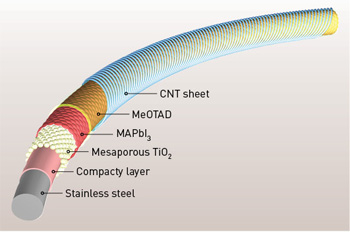 Fiber-shaped solar photovoltaic. H. Peng, Fudan University
Fiber-shaped solar photovoltaic. H. Peng, Fudan University
|
“Perovskites have the advantage of being easily made from solution,” Michael Grätzel of the Swiss Federal Institute of Technology in Lausanne said. “It nearly fulfills the dream of having a solar PV system that can be sprayed onto any surface—it’s worth the continuing effort.”
The conversion efficiency race
Ascertaining the deeper mysteries of halide perovskites, and turning minute differences into solar PV advantages, occupies the minds of many of the field’s leading researchers today. And those efforts have resulted in startling gains in conversion efficiencies in a short time. Specifically, the reported solar energy conversion efficiency has increased from 3.8 percent to 19.3 percent in just five years.
In the race to exploit perovskite as a PV material, the starting gun was arguably a 2009 publication by Tsutome Miyasaka and his group at the University of Tokyo, Japan. Miyasaka’s team thought to use perovskites—specifically, methylammonium lead halide—as a replacement for liquid sensitizers in its investigations of dye-based solar cells. When incorporated into a PV cell, this perovskite crystal efficiently sensitized TiO2 for visible-light conversion in photoelectrochemical cells and was sensitive to wavelengths of light up to 800 nm. Their perovskite PV yielded a solar energy conversion efficiency of 3.8 percent.
Miyasaka’s paper seems to have been the tipping point for other investigations into ABX-based perovskites. The race was on to find the ideal perovskite structure for absorbing light and converting it into energy.
In 2011, Nam Gyu Park’s group at Sungkyunkwan University, South Korea, revealed that a solid-state hole conductor, comprising CsSnI3–xFx, or spiro-MeOTAD (2,2'7,7'-tetrakis-(N,N-di-p-methoxyphenyl-amine)-9,9'-spirobifluorene), could be used to accelerate charge transport. This step resulted in a quick increase in conversion efficiency to 6.5 percent, while simultaneously improving the stability of perovskite PVs.
The following year, Henry Snaith’s group at the University of Oxford, U.K., increased the efficiency to 10.9 percent chiefly by integrating a mesoporous scaffold composed of alumina (Al2O3). However, alumina has a large band gap, which means that it is unable to aid in the extraction of excited electrons. Instead, Snaith reported, it was an unknown property of the perovskite itself that helped conduct the charge.
The next key finding was by Grätzel’s group in 2012. It found that CH3NH3PbI3itself acts as a hole conductor in a perovskite-based PV system. Combined with a TiO2scaffold, this allowed the overall film thickness to be no more than 200 to 300 nm, while maintaining a conversion efficiency higher than 9 percent. Another study a year later from the Grätzel team, lead-authored by Julian Burschka and Norman Pellet, reported changing to a sequential deposition method to increase power conversion efficacy to 15 percent by using a PbI3layer, then CH3NH3I.
This improvement was quickly followed by another in 2014 from Sang Il Seok and his team at the KRICT Institute in Daejeon, South Korea. Seok’s group controlled nucleation of CH3NH3PbI3crystals within TiO2scaffold, increasing power conversion efficacy to 17.9 percent.
Very recently, Yang’s group at UCLA has focused on optimizing the way in which charges are transported, with special attention to the interfaces between the various layers in thin-film perovskite. Yang and his team manipulated the behavior of the carrier recombination pathways by carefully selecting the layer materials and by controlling humidity at 30 percent while processing. During the annealing process, they noted that the film transformed in three stages, taking the material from a chloride-based phase to an iodide-based final dominant phase. This change in phases during a controlled humidity process increases the efficiency of the carrier transfer, ultimately leading to 19.3 percent cell efficiency without antireflective coatings.
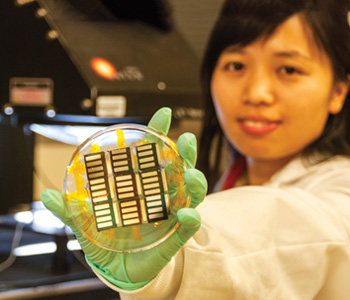 UCLA postdoc Huanping Zhou displays perovskite solar cells. Courtesy of UCLA
UCLA postdoc Huanping Zhou displays perovskite solar cells. Courtesy of UCLA
Flexibility leads to new forms
Unlike most inorganic materials, which are fragile, perovskite is very robust and bends easily. Nonetheless, there is some concern that, being crystalline, perovskites may develop cracks or other imperfections upon bending or rolling.
Henk Bolink and his colleagues at Universidad de Valencia, Spain, recently reported creating a flexible, thin-film solar cell that achieves power conversion efficiency as high as 7 percent, and exhibited very little drop-off in that rate when the device was bent several times to a diameter of 5.5 cm. To achieve this, they used a sandwiching method in which methylammonium lead iodide was surrounded by layers of aluminum-doped zinc oxide and silver. The entire cell was prepared on a 50-µm thick polyethylene terephthalate foil. Significantly, nearly the entire manufacturing process can be done at room temperature, with only one step performed at 90°C, which is below the point at which most polymers would be affected.
According to Bolink, they should be able to achieve a conversion efficiency of 15 percent in the near future, at least for medium-sized cells. He added, however, that using glass as a substrate is not completely out of the question.
“There is an interesting new development that is using very thin foils of glass, 100 µm thick,” he said, “yet [it still has] rather good thermal stability and high strength.” Bolink cites Corning’s Willow Glass as one example of this new substrate technology.
But if perovskite’s soft structure lends itself to a high degree of flexibility, it also can be chemically attacked from contact with air and water. Damage from external forces can be avoided by encapsulating perovskite cells with protective coatings, but the material also is prone to undergoing internal changes during operation due to structural modifications, typically from high operating temperatures caused by radiant sunlight. “In order to commercialize the perovskite solar cell, [these] two issues should be resolved,” says Park of Sungkyunkwan University, whose group was one of the first to successfully replace the liquid electrolyte in a dye-sensitized solar cell with a solid-state perovskite.
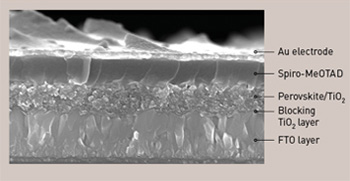 A cross-sectional scanning electron microscope image illustrates a tin-based perovskite solar cell. M. Kanatzidis, Northwestern University
A cross-sectional scanning electron microscope image illustrates a tin-based perovskite solar cell. M. Kanatzidis, Northwestern University
Getting the lead out
Lead toxicity is also a major concern for using perovskites in PVs. Per the European Union’s RoHS (restriction of the use of certain hazardous substances) regulations, the limit for lead in any device is 1,000 parts per million. In perovskite-based solar cells, the amount of lead is about 0.21 g/m2, which, according to Grätzel, is troubling. Tin and other replacement candidates have efficiency issues by comparison, but encapsulating lead-based cells seems to be the best option right now for battling everyday conditions in field use.
Park points out that there are some critical issues regarding the application of tin, which is chiefly used in its Sn2+ form. In air, tin is readily oxidized, which pulls it out of the iodide bonds, thus leaving a cation vacancy that must be compensated for via valence filling (similar to p-doping) at the risk of a loss in power conversion efficiency. Grätzel states that this aspect of the technology is still in its infancy, though he is optimistic that these issues will be sorted out.
Mercouri Kanatzidis of Northwestern University in Evanston, Ill., USA, and his colleagues are among the groups seeking a reasonable solution to the lead problem.
This June, Kanatzidis’ team reported some initial success with tin. The perovskite they developed, methylammonium tin iodide (CH3NH3SnI3), provides a band gap of just 1.3 eV, about a 16 percent red-shift compared with its lead counterpart, CH3NH3PbI3, giving the tin-infused material a broader solar absorption range. Used with a spiro-MeOTAD hole-transport layer, this version of perovskite produced a conversion efficiency of 5.23 percent. The investigators created another tin version, adding bromide to the solution (CH3NH3SnI3–xBrx), which helped bring the efficiency up to 5.73 percent.
As with other attempts using tin, Kanatzidis found that oxidation and hydrolysis were afflictions to be avoided, as they directly affected photocurrent density and fill factor. The lack of stability tin would suffer in field conditions warrants a longer look at methods to seal tin-based perovskite solar cells, according to Kanatzidis.
“If the perfect oxygen protection technique is developed,” Park said, “tin-based perovskite solar cells may survive.” And they may provide a solution to the lead problem.
Bisquert and his colleagues also are tapping into tin-based perovskites, further elucidating which properties to target for optimization. His team published separate insights into two interesting characteristics of lead halide perovskites: slow dynamic processes and a photo-induced giant dielectric constant.
In one report, Bisquert and his coauthors noted that the photovoltage decay times within perovskite-based solar cells are governed by a particularly slow reorganization process. This process is a result of the structural properties of lead halide perovskites themselves. There is no indication, however, that the slow process time affects perovskite’s ability to quickly and efficiently move a charge to its destination.
In the second letter, they reported that they had found that lead halide perovskites exhibit a “giant” dielectric constant (ε greater than one million), indicative of a highly polar material. Even when the material is kept in the dark, unexposed to light-induced photocurrent, the dielectric constant is about 1,000. The marked increase in dielectric constant occurs whether the material is exposed to light or to a charge injection at an applied bias, results in a very large capacitance, which in turn causes a slow impedance response within the megahertz frequency range. The polarization is a byproduct of changes in the crystal structure of the perovskite permitting easy separation of electrons and holes.
The perovskite structure plays the most significant role in the realization of such properties. In the normal ABX form, the B cation resides in a six-fold coordination with an octahedron of X anions; the A cation occupies the 12-fold cuboctahedral coordination site. Under stress or electrical field application, the form distorts, altering the material properties, if slightly.
“The causes of these exotic physical properties are not understood,” Bisquert adds. “Determining the structure-function relationship [within perovskites] is one of the main challenges at this point. If there is a wild internal drift of the elements that compose the structure, it will have to be stabilized.”
A perovskite-infused future
The rapid ascent of perovskites in the solar PV world has excited many solar-power fans. According to Grätzel, the next two years should see efficiencies as high as 20 percent, though he’s worried about the material’s stability, which still needs to be thoroughly investigated. But if perovskites are used in conjunction with other technologies, such as silicon cells, he says one could expect enhancements raising the efficiency of silicon panels up to 28 percent.
The long-term goal of Park’s group, meanwhile, is to achieve a perovskite solar cell with power conversion efficiency approaching 30 percent. He added that he would like to develop new PV materials, much better than current perovskites, by finding a general rule relating PV activity and the physico-chemical properties of PV candidate materials such as chemical bonds, electronic structure and crystal structure.
“Efficiency as high as 19 percent [has been] already reported,” Park said. He added that a perovskite solar cell with efficiency of 15 percent will cost about 20 cents per watt, an extremely low cost.
In this field, Bisquert added, one enjoys this type of big challenge, shared by a worldwide community. “We value originality, creativity and hard work. We meet a lot of interesting people and we have a lot of fun.”
Lynn Savage is a freelance writer who specializes in science and technology. He is the owner of Savage Editorial Services, Easthampton, Mass., USA
References and Resources
-
A. Kojima et al. J. Am. Chem. Soc. 131, 6050 (2009).
-
L. Etgar et al. J. Am. Chem. Soc. 134, 17396 (2011).
-
J.-H. Im, et al. Nanoscale 3, 4088 (2011).
-
H.S.-Kim, et al. Sci. Rep. 2, 591 (2012).
-
M.M. Lee et al. Science 338, 643 (2012).
-
J. Burschka et al. Nature 499, 316 (2013).
-
V. Gonzalez-Pedro et al. Nano. Lett. 14, 888 (2014).
-
N.J. Jeon et al. Nat. Mater. 13, 897 (2014).
-
P. Qin et al. J. Am. Chem. Soc. 136, 8516 (2014).
-
H. Zhou et al. Science 345, 542 (2014).
